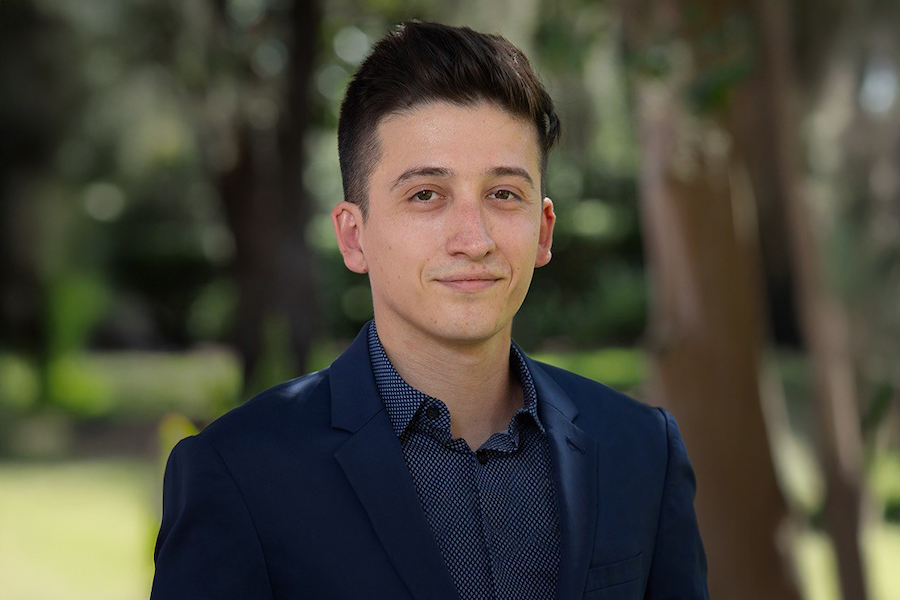Student Spotlight: CJ Guzman

CJ Guzman is a doctoral candidate studying physics through Florida State University’s Department of Physics, part of the College of Arts and Sciences. Guzman researches the magnetic fields of electrons at the FSU-headquartered National High Magnetic Field Laboratory, the world’s largest and highest-powered magnet lab. In 2023, Guzman earned a highly competitive McKnight Dissertation Fellowship to support his doctoral studies. In addition to his studies, Guzman presently works as a graduate research assistant in condensed matter science at the National Maglab.
Tell us a little about your background, where you’re from and what brought you to FSU.
I’m from Lockhart, Texas, and in 2019, I received my undergraduate degree in physics from Trinity University in San Antonio, Texas. My selection for the Department of Education’s McNair Scholars Program and the American Physical Society Bridge Program, which creates pathways to physics graduate programs for students from all backgrounds, opened my eyes to the opportunities afforded by a graduate education. I was sold on FSU once I learned about the research opportunities available at the National MagLab.
What inspired you to pursue a degree in physics?
My initial major was chemistry, but my introductory physics courses really caught my attention as I quickly digested the content and found myself eager to ask questions. Physics has taught me more logic and reasoning skills than I expected, and I’m resultantly much better at solving problems outside of the lab.
Can you break down your current areas of research for us?
My current research focuses on detecting and controlling the magnetic field of an electron, also known as its spin. Electron spins, along with other particle spins at this exceptionally small scale, are governed by the rules of quantum mechanics, which deal with the mathematical description and interactions of subatomic particle motions. Electron spins behave very differently than a typical spinning top. Quantum rules allow the electron spin to appear as if it can occupy multiple states of movement, such as spinning up or down at once, and my research group is working on devices that can control and measure these multi-state orientations.
What do you want the public to know about the importance of your research?
An electron spin state can be used to encode binary information exactly like typical computers, which store and manipulate information using transistors. However, the quantum mechanics behind electron spins are fundamentally impossible to execute on any transistor-based, or typical modern computer. This has led to the development of quantum computers and algorithms with the capability to accelerate performance in a vast number of fields such as logistics, medical research and cybersecurity.
For example, quantum computers can optimize algorithms and therefore improve the efficiency of things like everyday delivery routes and airline scheduling. Quantum computing can also improve cybersecurity, as certain quantum cryptographic protocols can detect if and when a malicious entity intercepts sensitive data. Additionally, medical and biological researchers can use quantum computers to simulate protein folding and novel drug designs, for instance, much faster than a typical supercomputer.
What does earning the McKnight Dissertation Fellowship mean to you?
I was honored to earn the fellowship, and it helped to meet people like me who didn’t grow up in families where graduate school, or even college, was talked about. A sense of community is very important to me, and I’m grateful to have joined the McKnight family.
What aspect of your studies do you find most rewarding?
Most of the time, the real-world issues I face in the lab don’t have elegant solutions, and I’ve learned to apply several physics concepts at once to reach a successful outcome, which has shaped my mindset to view problems through various lenses.
What are some current goals or projects you’re working on?
I’m currently working on optimizing sensitive devices to measure electron quantum spin states. The sensitivity requirements dictate certain dimensions be 30 nanometers or less, making my devices more than 1,500 times smaller than the average width of a strand of human hair. These devices are fabricated using electron beam lithography, which can etch patterns on materials using a focused beam of electrons. The process is incredibly sensitive to external noise from electronic devices, stray magnetic fields, and even voices above a whisper.
Are there any faculty or staff who have helped or inspired you?
One of my doctoral committee members, professor of physics Nicholas Bonesteel, has been instrumental in advancing my interest in quantum computing. I took his Introduction to Quantum Computing and Quantum Information course in Fall 2022, and his ability to break down complicated algorithms into understandable explanations pushed me to take another quantum algorithms course in FSU’s Department of Computer Science. Bonesteel also offered me a teaching assistantship in his introductory course for the FSU Young Scholars Program, a six-week summer program for 40 of Florida’s highest-performing high school students with significant potential for careers in the fields of science, technology, engineering and mathematics. I enjoyed interacting with such motivated students, and this experience furthered my passion for physics education as well as the field of quantum computing.
Following your graduation, what are your plans? Even though you might miss FSU, what are you looking forward to once you graduate?
I’m planning on moving back to Texas, hopefully San Antonio. I’m looking forward to being around my family and friends again while pursuing my ideal career of being a lead research scientist at a quantum computing company.

